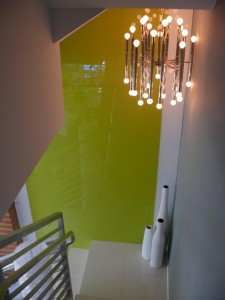Backpainted Plexiglas using glass paint
 Glass paint can be used on Plexiglas, just like it can be used on a glass surface. Glassprimer™ glass paint will make a permanent bond with Plexiglas. Since Plexiglas is more flexible than glass, backpainted Plexiglas can be used in a wide range of applications.
Glass paint can be used on Plexiglas, just like it can be used on a glass surface. Glassprimer™ glass paint will make a permanent bond with Plexiglas. Since Plexiglas is more flexible than glass, backpainted Plexiglas can be used in a wide range of applications.
Backpainted Plexiglas is flexible and lightweight
For large installations, Plexiglas is preferred, since it is lightweight, inexpensive and can be precision-cut to fit tight locations. The only areas in which backpainted Plexiglas should not be used are those where extreme temperature fluctuations are likely. This includes kitchen spaces and areas around fireplaces.
It’s most convenient to cut the Plexiglas to its final shape prior to painting. Cutting the Plexiglas first will avoid the possibility of damaging the paint during the cutting process.
As with glass, a successful backpainted Plexiglas project requires some simple surface preparation. To prepare Plexiglas, first wash it to remove dirt, dust and grease that might interfere with good coverage or adhesion. You can wash Plexiglas with any soap or surface preparation that removes grease and dirt.
Standard rubbing alcohol (isopropyl alcohol) can also be used to clean the surface, even though alcohol can soften Plexiglas over a long period of constant exposure. Plexiglas can be safely exposed to household cleaners containing ammonia or bleach. (As a caution, do not combine cleaners that contain ammonia and bleach because that solution will produce a noxious, toxic gas called chloramine.)
Once the Plexiglas is cleaned, you can dry it with regular paper towels. Plexiglas is prone to developing a static charge that will attract lint, dust and pet hair. As with glass preparation, avoid using “lint-free” paper towels or new cleaning towels that may shed lint on the newly cleaned Plexiglas.
When the Plexiglas is dry, sand it gently with fine grit sandpaper or steel wool. This will lightly abrade the surface of the Plexiglas and help the paint to adhere. After sanding, rewipe the surface of the Plexiglas to remove any debris or dust created by the sanding.
Once the surface is dry, it is ready to be painted. You can apply paint using a brush, roller or spray gun. As with glass, a paint sprayer will provide the most uniform application, and will help conserve paint. Apply a thin coat of paint to the surface and allow it to dry to the touch. A thin coat will dry more quickly and you can avoid runs and drips. Apply as many coats as needed to achieve the desired result.
Once the paint has completely dried and cured, you can attach the backpainted Plexiglas to the surface using a neutral cure silicone glue.
If you’d like more information about working with Glassprimer™ glass paint, please check out our site!
